Wednesday Feb 12, 2025
Wednesday Feb 12, 2025
Saturday, 9 April 2016 00:00 - - {{hitsCtrl.values.hits}}
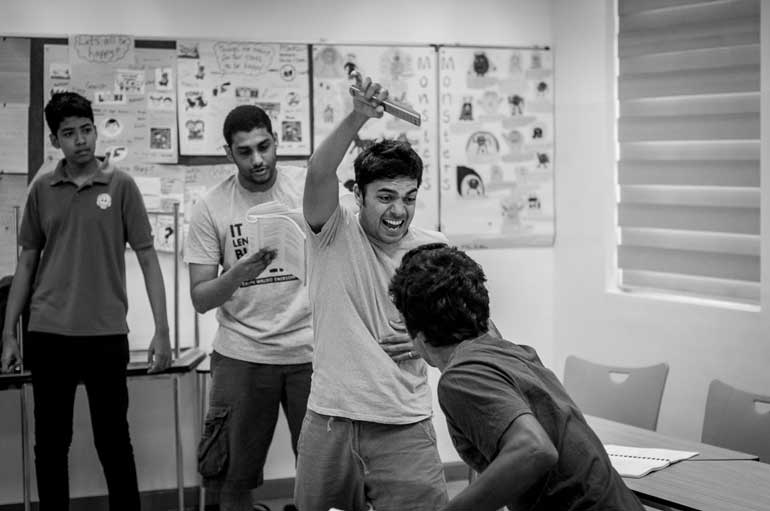
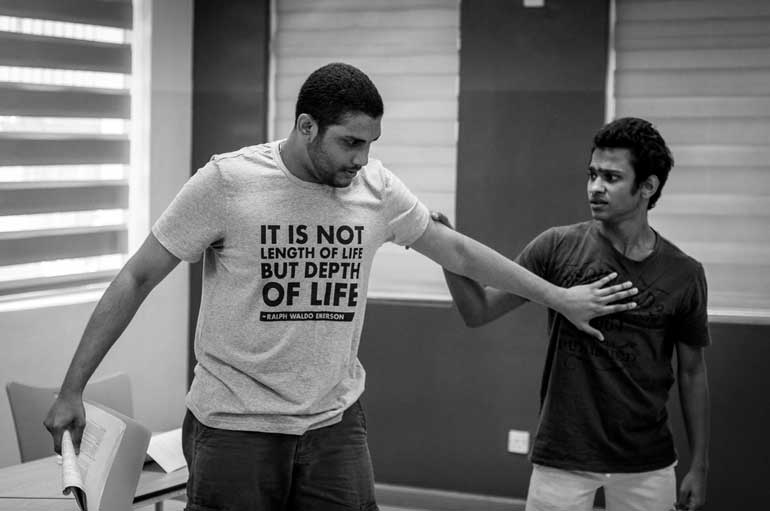
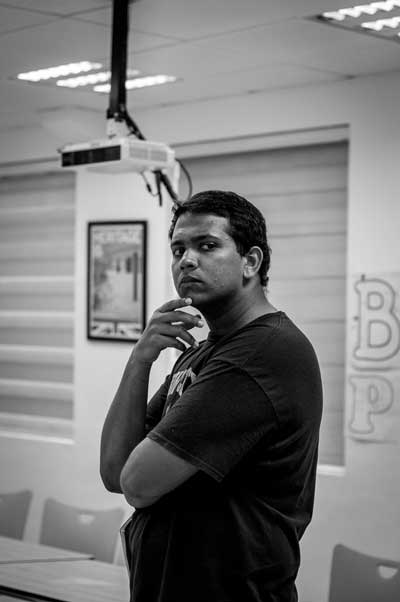
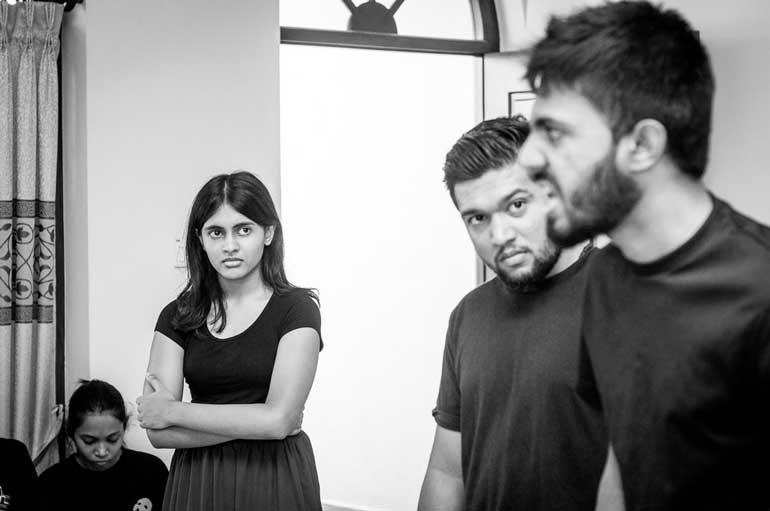
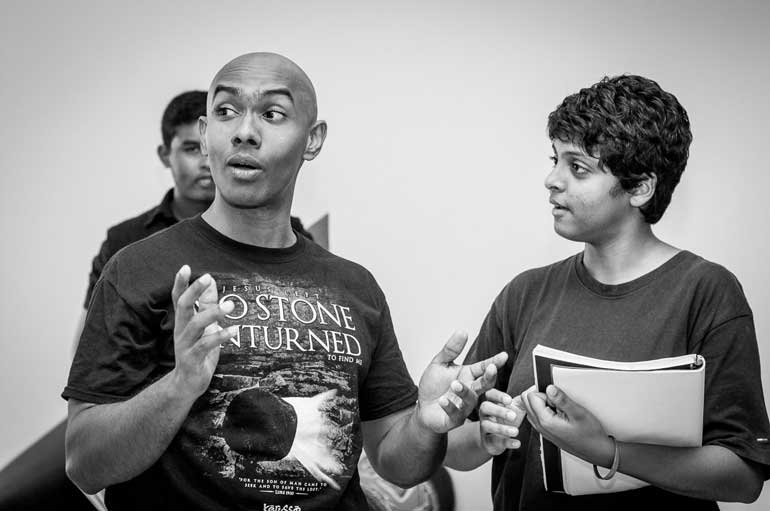
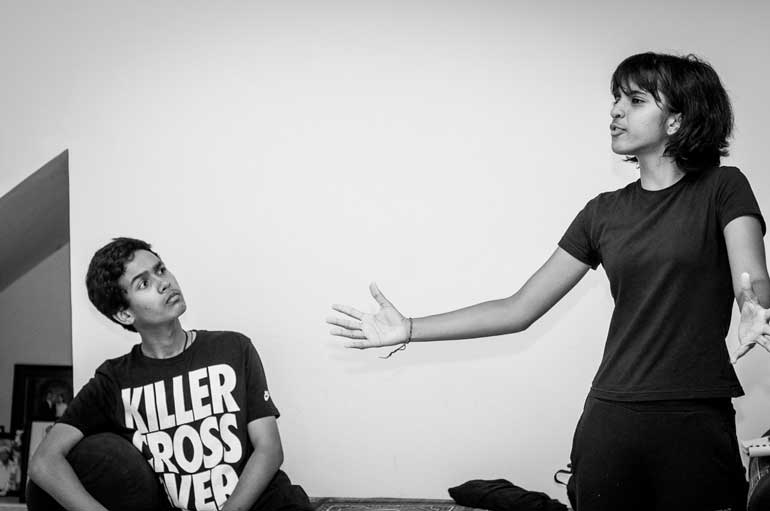
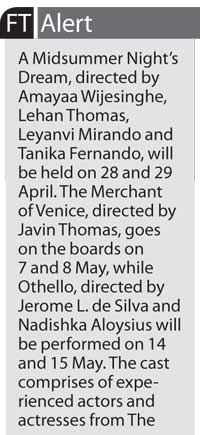 One of the foremost theatre groups in the country, The Workshop Players present ‘Shakespeare in the Park’, a popular concept that makes Shakespeare’s performances accessible to theatre lovers from all walks of life.
One of the foremost theatre groups in the country, The Workshop Players present ‘Shakespeare in the Park’, a popular concept that makes Shakespeare’s performances accessible to theatre lovers from all walks of life.
Founded in the USA as a New York Shakespeare Festival, it has gained recognition and popularity in many parts of the world. The Workshop Players will be performing three plays that feature in the O level, A Level and University curricula. A long-term sponsor of the many endeavors of the Workshop Players, Cargills Ceylon PLC and Cargills Magic will be supporting this project, along with The British Council of Sri Lanka.
The Bard enjoys immense appreciation in Sri Lanka, with Shakespeare’s work being studied in schools and universities, increased participation at the annual inter-school Shakespeare Drama Competition, and amateur theatre groups and schools producing public 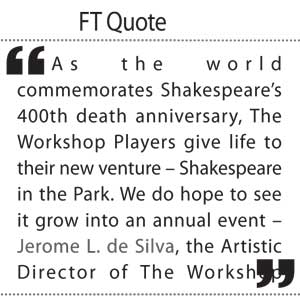 performances of Shakespeare’s plays.
performances of Shakespeare’s plays.
Endorsing this effort, Tanya Warnakulasuriya, Arts Manager/Programmes of the British Council said: “The British Council Arts programme is committed to making the Arts accessible to everyone. So, having The Workshop Players as our new Artists-in Residence and supporting them to produce Sri Lanka’s first-ever Shakespeare in the Park, is a perfect partnership for us. This is exactly how Shakespeare’s plays should be experienced.”
“As the world commemorates Shakespeare’s 400th death anniversary, The Workshop Players give life to their new venture – Shakespeare in the Park. We do hope to see it grow into an annual event. Thank you Cargills Ceylon PLC and The British Council for your support,” said Jerome L. de Silva, the Artistic Director of The Workshop Players.
The three plays selected for the festival include A Midsummer Night’s Dream, The Merchant of Venice, and Othello. While they are currently studied as texts by students of English literature, they also provide a range of genres and styles to entertain audiences.
A Midsummer Night’s Dream, directed by Amayaa Wijesinghe, Lehan Thomas, Leyanvi Mirando and Tanika Fernando, will be held on 28 and 29 April. The Merchant of Venice, directed by Javin Thomas, goes on the boards on 7 and 8 May, while Othello, directed by Jerome L. de Silva and Nadishka Aloysius will be performed on 14 and 15 May. The cast comprises of experienced actors and actresses from The Workshop Players.
Commenting on the association, Maljini Jayasekera, Group Manager – Marketing for Cargills said: “As a corporate that has consistently supported the empowerment of young people, we are committed to investing in the talent and potential of local artists.
We have always believed that the workshop players is a group that enhances our talent and positions our theatre at international standards. We are confident that our consistent support to them and many such theatre groups has helped enhance local artistic potential and we are now delighted to take Shakespeare to reach every single theatre lover through what would be an open house appreciation of the bard.”
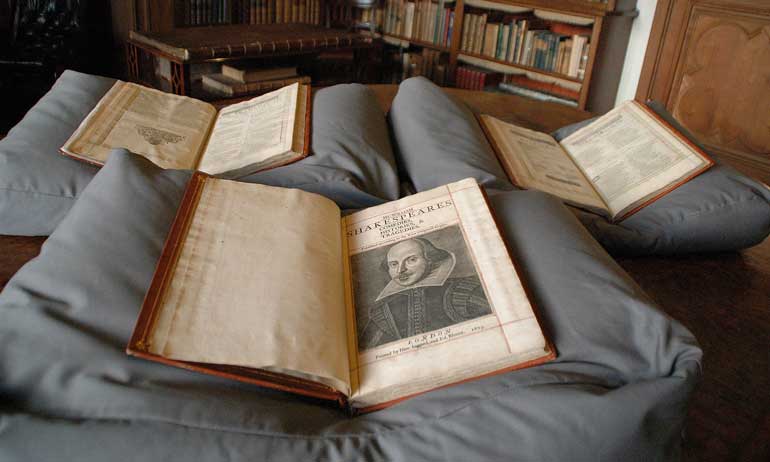
The copy of Shakespeare’s first folio discovered at Mount Stuart on the Isle of Bute. The edition is unusual because it was bound in three volumes. Photograph: University of Oxford/PA
www.theguardian.com: A copy of Shakespeare’s first folio – a book containing 36 of his plays published seven years after his death – has been discovered at a stately home on a Scottish island.
The book, which has languished in the library of Mount Stuart on the Isle of Bute for more than 100 years, was confirmed as genuine by Emma Smith, professor of Shakespeare studies at Oxford University.
Published in 1623, the first folio brought together the majority of Shakespeare’s plays and without it there would be no copies of more than half of them, including Macbeth and The Tempest.
The find brings the total number of known copies to 234 ahead of the 400th anniversary of the playwright’s death on 23 April.
Mount Stuart’s copy belonged to Isaac Reed, a well-connected literary editor working in London in the 18th century, Smith said.
A letter from Reed shows he acquired it in 1786 and further records indicate it was sold after Reed’s death in 1807 to a “JW” for £38.
After this sale there are no public records of the folio and it was not included in Sidney Lee’s 1906 census of first folios.
It was at some point between these two dates that Mount Stuart acquired the book because it is mentioned in a catalogue of the library in 1896.
The Mount Stuart edition is unusual because it was bound in three volumes with many blank pages which would have been used for illustrations.
Smith said: “When we think of Shakespeare we usually think of his plays being performed on stage. But the written word and the first folio is central to our understanding of Shakespeare. I hope this anniversary year encourages people to reread the texts of his work.”
The discovery will form the focal point for a new education programme and will go on display from 7 April at Mount Stuart as part of an exhibition that will run until 30 October.
The head of collections at Mount Stuart, Alice Martin, said: “In terms of literary discoveries, they do not come much bigger than a new first folio, and we are really excited that this has happened on Bute.”
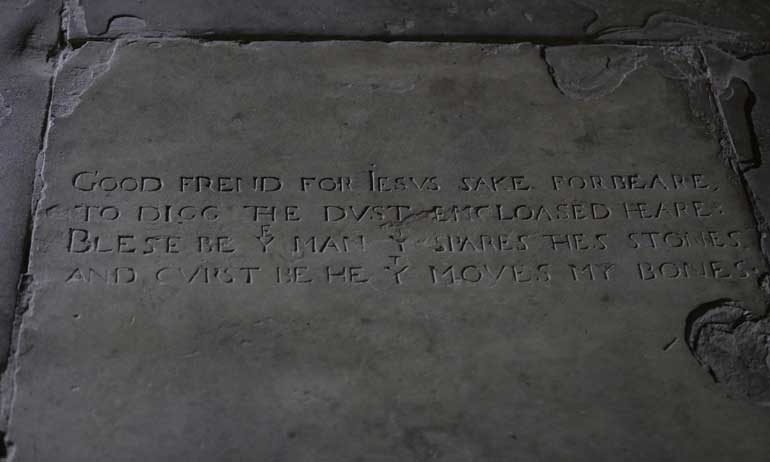
Inscription on Shakespeare’s grave at Holy Trinity church in Stratford-on-Avon
A story often dismissed as wild fiction, that 18th-century grave robbers stole Shakespeare’s skull, appears to be true, archaeologists have said.
The first archaeological investigation of Shakespeare’s grave at Holy Trinity church in Stratford-on-Avon was been carried out for a documentary broadcast by Channel 4 end March.
The most striking conclusion is that Shakespeare’s head appears to be missing and that the skull was probably stolen from what is a shallow grave by trophy hunters.
Kevin Colls, the archaeologist who led the team, said the grave was not as they had expected. “We came across this very odd, strange thing at the head end. It was very obvious, within all the data we were getting, that there was something different going on at that particular spot. We have concluded it is signs of disturbance, of material being dug out and put back again.”
There is also “a very strange brick structure” that cuts across the head end of the grave, he said.
All of that gives credence, Colls said, to a story published in the Argosy magazine in 1879 that Shakespeare’s skull was stolen from Holy Trinity in 1794. “Grave-robbing was a big thing in the 17th and 18th century,” said Colls. “People wanted the skull of famous people so they could potentially analyse it and see what made them a genius. It is no surprise to me that Shakespeare’s remains were a target.”
Shakespeare’s grave is visited by hundreds of visitors each year, a number that may increase in 2016 – the 400th anniversary of his death.
It carries no name, only a slightly disturbing warning: “Good friend, for Jesus’ sake forbear, / To dig the dust enclosed here. / Blessed be the man that spares these stones, / And cursed be he that moves my bones.”
The archaeological team used non-invasive ground-penetrating radar (GPR) to examine the grave and were able to put to bed a few myths about Shakespeare’s burial.
For example, one story suggests he was buried standing up, as his friend and fellow writer Ben Jonson is in Westminster Abbey. Another claims that he was buried 17ft deep to avoid being disturbed, while one says he was buried in a family tomb.
None of those stories are true, the team has concluded. Instead he is buried about 3ft deep and had been wrapped simply in a shroud rather than placed in a coffin.
Their conviction that Shakespeare’s skull was stolen led the team to investigate another story – that the real skull is in fact 15 miles away in the crypt of St Leonard’s church in the village of Beoley, Worcestershire.
The team scanned the skull and carried out a forensic anthropological analysis and the results revealed it could not be Shakespeare. “It was an unknown woman in her 70s,” said Colls, whose team even did a facial reconstruction to hammer the point home. Colls said he is convinced Shakespeare’s skull was removed from his grave but accepts the evidence is not conclusive. However, the vicar of Holy Trinity, the Rev Patrick Taylor, is not so certain.
“We now know much more about how Shakespeare was buried and the structure that lies underneath his ledger stone,” he said. “We are not convinced, however, that there is sufficient evidence to conclude that his skull has been taken.
“We intend to continue to respect the sanctity of his grave, in accordance with Shakespeare’s wishes, and not allow it to be disturbed. We shall have to live with the mystery of not knowing fully what lies beneath the stone.”
Discover Kapruka, the leading online shopping platform in Sri Lanka, where you can conveniently send Gifts and Flowers to your loved ones for any event including Valentine ’s Day. Explore a wide range of popular Shopping Categories on Kapruka, including Toys, Groceries, Electronics, Birthday Cakes, Fruits, Chocolates, Flower Bouquets, Clothing, Watches, Lingerie, Gift Sets and Jewellery. Also if you’re interested in selling with Kapruka, Partner Central by Kapruka is the best solution to start with. Moreover, through Kapruka Global Shop, you can also enjoy the convenience of purchasing products from renowned platforms like Amazon and eBay and have them delivered to Sri Lanka.
Discover Kapruka, the leading online shopping platform in Sri Lanka, where you can conveniently send Gifts and Flowers to your loved ones for any event including Valentine ’s Day. Explore a wide range of popular Shopping Categories on Kapruka, including Toys, Groceries, Electronics, Birthday Cakes, Fruits, Chocolates, Flower Bouquets, Clothing, Watches, Lingerie, Gift Sets and Jewellery. Also if you’re interested in selling with Kapruka, Partner Central by Kapruka is the best solution to start with. Moreover, through Kapruka Global Shop, you can also enjoy the convenience of purchasing products from renowned platforms like Amazon and eBay and have them delivered to Sri Lanka.